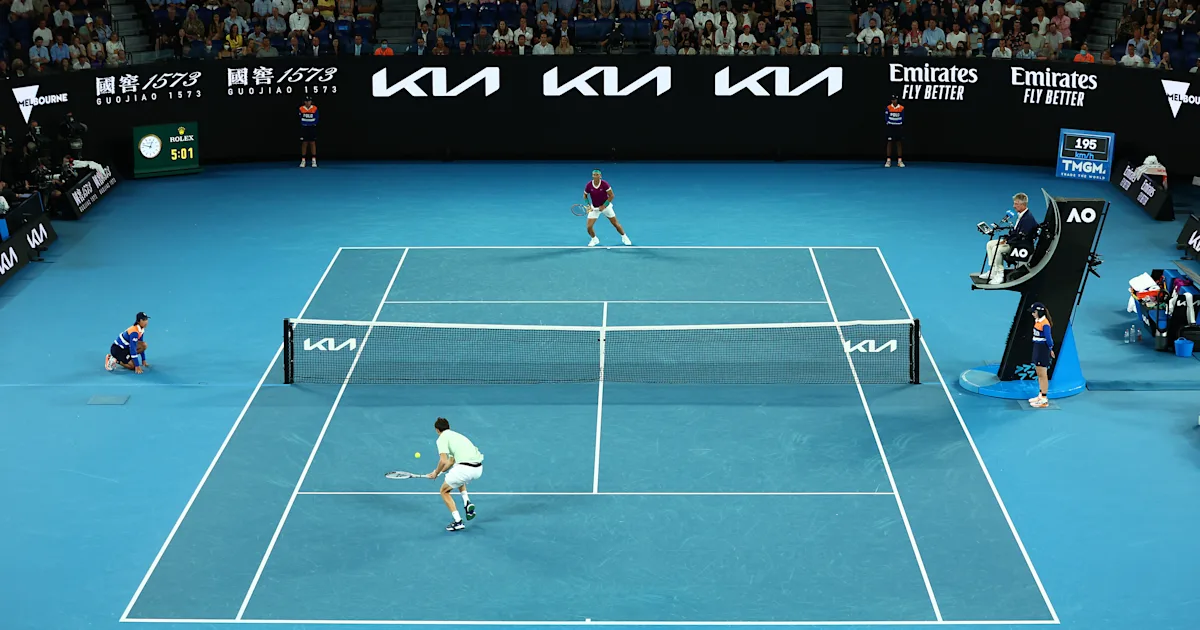
If you are new to the thrilling game of tennis, you would want to know what the tennis tiebreaker is. It’s like the offside rule in football: a bit mysterious for an outsider. But, it’s a simple set of rules that anyone can learn in minutes.
The tiebreaker is a crucial part of tennis. In contrast to the anti-climactic offside rule, the tiebreaker generates the highest tension in the match. It’s at that time the true quality of a player shines. It makes up for the most entertaining part of a tennis match.
So, what is a tiebreaker? The rules are simple to understand. Just read this article to equip yourself with this vital tennis knowledge and watch games like a pro.
When is the Tiebreaker Triggered?
The tiebreaker is a set-deciding round that is triggered when players are 6 all in a set. The tiebreaker is designed to decide the winner of the set.
What is a Tiebreaker?
There are two major types of tiebreakers in tennis: a 7-point and a 10-point tiebreaker. The 7-point tiebreaker was the dominant format in singles until recently. This changed following an experimental reshuffle by the tennis governing bodies.
Players play the tiebreaker point-for-point until one of them reaches 7 points in the first sets and 10 points in the final set. If the score in the tiebreaker is 6-6 or 9-9, the players continue until one of them gets a two-point lead. The winner of the tiebreaker is awarded the set, with a score of 7-6. The score from the tiebreaker is usually left in brackets.
The tiebreaker can be avoided if the result is 6 to 5 games, for example, and the player in the lead takes the next game for 7-5. It only gets triggered at 6 games all.
Types of Tiebreakers
There are several types of tiebreakers in tennis. Until recently, organizers of major tournaments used different tiebreakers. Here are the types:
12-Point Tiebreaker
This best-of-12 special round is also known as the 7-point tiebreaker. Players race to reach seven points. If the score is 6-6, play continues until one of them takes a lead by two points.
10-Point Tie Break
This special round is played to 10 points, instead of 7. It leaves a bit more middle room for players to get a two-point lead before reaching 10. It is widely applied across tournaments.
‘Sudden Death’ 9-Point Tiebreaker
Otherwise known as ‘Super Tiebreaker’, this old format was played in a best of nine. At 4-4, the next player who scored a point won the set on the spot. It was widely used before the introduction of the two-point rule. It waned in popularity in the 80s, 90s, and 00s, but it is still used on rare occasions. The last match won with ‘sudden death’ was in the 2020 World Team Tennis.
Rules of the Tiebreaker: Serves, Trading Sides, Points
The player who has been on the receiving end of service gets to serve first at the beginning of the tiebreaker. He only serves once before the service is awarded to the other player. From there on, each player serves twice in a row until the conclusion. If we are to cap the serving order simply, it is Player A, Player B, Player B, Player A, Player A, Player B, Player B, etc.
The order of serving for the doubles game is a bit different since there are four players involved. It is Player 1, Opposite Player 1, Opposite Player 1, Player 2, Player 2, Opposite Player 2, Opposite Player 2, and so on.
Players also alternate between the deuce and ad side when serving. Every six points, they switch court sides. This is designed to eliminate any inequalities of play – such as the direction of the sun rays or wind (if any).
In comparison to normal play, each point scored by a player during the tiebreaker is counted as one. In normal play, the format is 15, 30, and 40. In the tiebreak, it’s 1-0, 2-0, 3-0, etc.
The Psychological Dimension of the Tiebreaker
The tiebreaker doubles the stakes of normal play. A simple mistake during the tiebreaker can cost the set, and even the match. It risks devaluating all prior strenuous efforts to get there. It can be very disappointing for players when it happens.
The increased tension forces a player to scoop deep from his physical and mental reservoir. You will often see them using the following mind games in their quest for victory:
1. Win the first two points
The player who serves first has an advantage. He will try to win his serve and then play like a monster to try and break to gain a psychological advantage over his opponent.
2. Dominate first serves
It can be painful for a player to get their first serve wrong during the tiebreaker. They often try to get their first serve in, as best as they can, to avoid putting pressure on themselves. It’s a balancing act between taking risks and going hard.
3. Netplay
In the tiebreaker, the key to success lies in victory in the mental compartment. Players are well aware of this. Some of them try to exert psychological pressure on their opponent by rushing to the net as soon as they can.
4. Focus and positivity
The tiebreaker is the most psychological part of the tennis game. The best players are those who to contain their emotions, remain positive, and run their socks off for every ball. It’s a nerves game. It’s all about being able to withstand the psychological pressure.
History of the Tiebreaker
The tiebreaker rule saw the light of day in the early 70s. It was introduced in an attempt to curb the possibility of unending matches that often resulted from the ‘advantage set’ rule. The first form of the tiebreaker involved players battling to reach five points. There was no two-point-lead rule. Instead, at 4-4, the sudden death rule was applied. This format was the brainchild of Jimmy Van Alen.
In short time, players started to complain that the ‘sudden death’ rule was too taxing on the nerves. Some even joked that it threatened to turn literal. Either way, they petitioned against the rule in favor of a more fluid format. The 7-point tiebreaker came into being thanks to the proposition of Rod Laver, a tennis legend.
In the aftermath of the 11-hour thriller between Isner and Mahut, the Grand Slam Board unified tiebreaker rules across all events. As a result, the 7-point breaker for the final set was replaced by a 10-point tiebreaker. The new rule was introduced in March 2022 and runs throughout the 2022-23 Grand Slam year.
The Longest Tiebreaker on Record
The longest tiebreaker occurred between John Isner and Nicholas Mahut: 70-68 in favor of Isner. The game was so unique; it spurred officials to make changes in the tiebreaker rules for future games.
Who has won the most tiebreakers in tennis history?
If there is a piece of statistic that showcases a tennis player’s masterful unification of skills and mental brawn, it is their tiebreaker win rate. To date, Roger Federer holds the bragging rights with a 65.1% win rate – or 432 wins out of 664 tiebreakers. Arthur Asse, Novak Djokovic, Andres Gomez, and Pete Sampras trail close with 64.9%, 63.3%, 63.2%, and 62.8%, respectively.
Summary
The tiebreaker is one of the harder rules to grasp in tennis, but also, one of the most thrilling aspects of the game. Until recently, the 7-point tiebreaker was used in most major tournaments. This changed in 2022 when the 10-point tiebreak was introduced for the deciding set. This means that the player who first reaches 10 points wins the set and match. The change aimed to spare embattled spectators who were unlucky enough to stumble on a 6-hour game. It also aimed to even the scales between singles and doubles tennis. The new rule makes doubles games shorter and more entertaining. The verdict is in the air about the reshuffle. We’ll find out if they’ll keep the rule for the future.
FAQ
What is a tiebreaker?
A tiebreak is a special round played when the games are 6 all. Players need to reach 10 points with a two-point advantage to snatch the set.
When is the tiebreaker triggered?
It is triggered when the score is 6-6 in any set.
Who serves first?
The player who was on the receiving end of service in the previous game gets to serve first in the tiebreaker.
How many serves does a player have?
Players have two serves in a row – except the first serve in the tiebreaker, which is on its own.
When do players switch courts in the tiebreaker?
Players switch court sides every six serves in singles and doubles. In doubles, players cannot switch sides during a set. This leaves them anchored either to deuce or ad until the set ends.
What types of tiebreakers are there?
There are two major types: 7-point and 10-point. 10-point is widely used for deciding sets.
Do Grand Slams use 7-point or 10-point tiebreakers?
Since March 2022, all Grand Slam tournaments use a 7-point tiebreaker for the first four sets and a 10-point tiebreaker for the fifth and final set.
Hi there! I'm Jake Steinberg, a passionate sports journalist with a knack for diving deep into the stories of inspiring sportsmen and sportswomen. Every athlete has a tale, and it's my mission to bring theirs to light. Join me on this journey through the highs and lows of the sporting world!


Motorsport
Motorsports Racing Industry Statistics

Hockey Wags
Nazem Kadri’s Wife: Jewelry Queen Ashley Cave





















